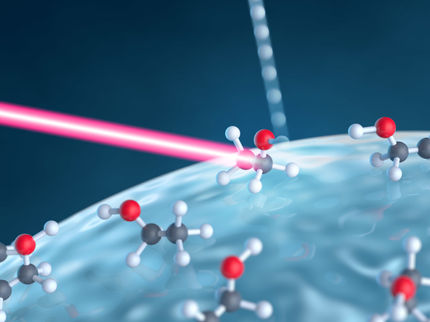Light-Controlled Reactions at the Nanoscale
Physicists used for the first time laser light to control the location of light-induced reactions on the surface of nanoparticles
Controlling strong electromagnetic fields on nanoparticles is the key to triggering targeted molecular reactions on their surfaces. Such control over strong fields is achieved via laser light. Although laser-induced formation and breaking of molecular bonds on nanoparticle surfaces have been observed in the past, nanoscopic optical control of surface reactions has not yet been achieved. An international team led by Dr. Boris Bergues and Prof. Matthias Kling at Ludwig-Maximilians-Universität (LMU) and the Max Planck Institute of Quantum Optics (MPQ) in collaboration with Stanford University has now closed this gap. The physicists determined for the first time the location of light-induced molecular reactions on the surface of isolated silicon dioxide nanoparticles using ultrashort laser pulses.

A nanoparticle in the field of a femtosecond laser pulse with tailored waveform and polarization. The controlled enhancement of the field in specific nanoscopic regions of the nanoparticle (yellow spots) induces site-selective photochemical reactions of the molecules adsorbed on the surface. Imaging of the molecular fragments emitted from these regions enables all-optical control of the reaction sites with nanometer resolution.
RMT Bergues
There is hustle and bustle on the surface of nanoparticles. Molecules dock, dissolve and change their location. All this drives chemical reactions, changes matter and even gives rise to new materials. The events in the nanocosmos can be controlled with the help of electromagnetic fields. This has now been demonstrated by a team led by Dr. Boris Bergues and Prof. Matthias Kling from the Ultrafast Electronics and Nanophotonics Group. To this end, the researchers used strong, femtosecond-laser pulses to generate localized fields on the surfaces of isolated nanoparticles. A femtosecond is one millionth of a billionth of a second.
Using so-called reaction nanoscopy, a new technique recently developed in the same group, the physicists were able to image the reaction site and birthplace of molecular fragments on the surface of silica nanoparticles - at a resolution better than 20 nanometers. The nanoscopic spatial control, achievable at even higher resolution, was brought about by the scientists by superimposing the fields of two laser pulses with different color, and controlled waveform and polarization. Thereby, they had to set the time delay between the two pulses with attosecond accuracy. An attosecond is still a thousand times shorter than a femtosecond. When interacting with this tailored light, the surface of the nanoparticles and the molecules adsorbed there were ionized at targeted sites, leading to the dissociation of the molecules into different fragments.
"Molecular surface reactions on nanoparticles play a fundamental role in nanocatalysis. They could be a key to clean energy production, in particular via photocatalytic water splitting," explains Matthias Kling. "Our results also pave the way for tracking photocatalytic reactions on nanoparticles not only with nanometer spatial resolution, but also with femtosecond temporal resolution. This will provide detailed insights into the surface processes on the natural spatial and temporal scales of their dynamics," adds Boris Bergues.
The scientists anticipate that this promising new approach can be applied to numerous complex isolated nanostructured materials.
Original publication
Wenbin Zhang, Ritika Dagari, Philipp Rosenberger, Ana Sousa, Marcel Neuhaus, Weiwei Lii, Shrjeel A. Khan, Ali Alnaser, Emiliano Cortes, Stefan Maier, Cesar Costa-Vera, Matthias F. Kling, Boris Bergues; All-optical nanoscopic spatial control of molecular reaction yields on nanoparticles; Optica, April 2022
Original publication
Wenbin Zhang, Ritika Dagari, Philipp Rosenberger, Ana Sousa, Marcel Neuhaus, Weiwei Lii, Shrjeel A. Khan, Ali Alnaser, Emiliano Cortes, Stefan Maier, Cesar Costa-Vera, Matthias F. Kling, Boris Bergues; All-optical nanoscopic spatial control of molecular reaction yields on nanoparticles; Optica, April 2022
Topics
Organizations
Other news from the department science
These products might interest you

NANOPHOX CS by Sympatec
Particle size analysis in the nano range: Analyzing high concentrations with ease
Reliable results without time-consuming sample preparation

Eclipse by Wyatt Technology
FFF-MALS system for separation and characterization of macromolecules and nanoparticles
The latest and most innovative FFF system designed for highest usability, robustness and data quality

DynaPro Plate Reader III by Wyatt Technology
Screening of biopharmaceuticals and proteins with high-throughput dynamic light scattering (DLS)
Efficiently characterize your sample quality and stability from lead discovery to quality control

Get the chemical industry in your inbox
By submitting this form you agree that LUMITOS AG will send you the newsletter(s) selected above by email. Your data will not be passed on to third parties. Your data will be stored and processed in accordance with our data protection regulations. LUMITOS may contact you by email for the purpose of advertising or market and opinion surveys. You can revoke your consent at any time without giving reasons to LUMITOS AG, Ernst-Augustin-Str. 2, 12489 Berlin, Germany or by e-mail at revoke@lumitos.com with effect for the future. In addition, each email contains a link to unsubscribe from the corresponding newsletter.



























































